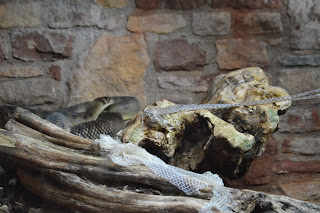 |
| Amethystine Python, Bristol |
Amethystine pythons get their name for the purplish iridescence of their scales, and are the largest snake in Australasia, with the range extending into parts of Indonesia and the Philippines There are four subspecies recognised across this broad range, with the largest individuals found on the mainland of Australia, where they are usually referred to as Scrub Pythons. The very largest females may exceed 6m in length, but more usually 4-5m is the maximum size. More recent work has split the species into 5, with the Australian mainland form now called M. kinghorni, and the true M.amethistina only found in New Guinea. Even within New Guinea, they are quite variable. The zoo's pair belong to the form known as the “Sorong Bar-Necked”, which originates from the Sorong Peninsula.
Amethystine pythons have a similar diet to most large snakes – basically anything they can catch, although warm blooded prey such as cuscus or wallabies, plus some birds is the most likely. They are also known to take monitor lizards on occasion. As with all pythons, heat sensitive pits in the upper lip help in tracking such prey after dark, when they become active. Visitors to zoos (and indeed private owners) often underestimate how active pythons or boas are because they only see them in the day, when they will be sleeping, or at least resting. After dark they embark on the search for food which can carry them long distances. Amethystines, like most snakes, are also good swimmers, which has helped to disperse them across the islands in their range.
In their native habitat Amethystines are mainly associated with dense forest. Small individuals tend to be arboreal, and at this stage they probably prey heavily on sleeping birds at night. To help with this they have extremely large teeth, the largest of any python, which helps them get a good grip despite feathers. This also means a bite can be quite serious, so extra precautions are needed when feeding. As is common with tree dwelling snakes, they can extend their bodies horizontally long disctances, which means their strike range can be over a third of their body length if they have a good grip – another reason to take precautions. As they get larger they become more terrestrial, but are still pretty good climbers.
As with other pythons, Amethystines are egg-laying snakes, with the female coiling around her eggs (usually 20-25 in number) and “shivering” to raise her body temperature and speed incubation. The eggs take around 90 days to hatch, and the neonates are around 60-70cm long. At this stage they take fuzzies (part grown mice), moving on to adult mice and then rats or quail as they grow.
At present, the Amethystine Python is listed by the IUCN as Least Concern, in view of its wide range and adaptability to human modified habitats. There are some in the pet trade, but they have a (justified) reputation for being tricky and rather aggressive animals, so there is little demand for them by private owners. A bigger threat is probably collection for the leather trade, but this is not a major concern at present.
No comments:
Post a Comment